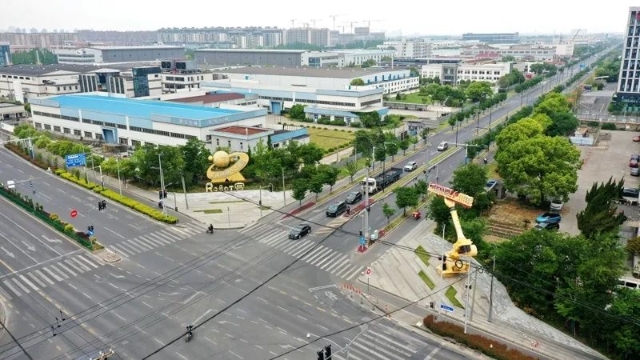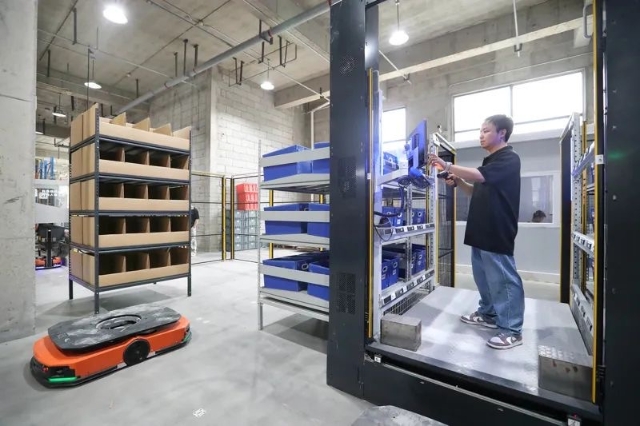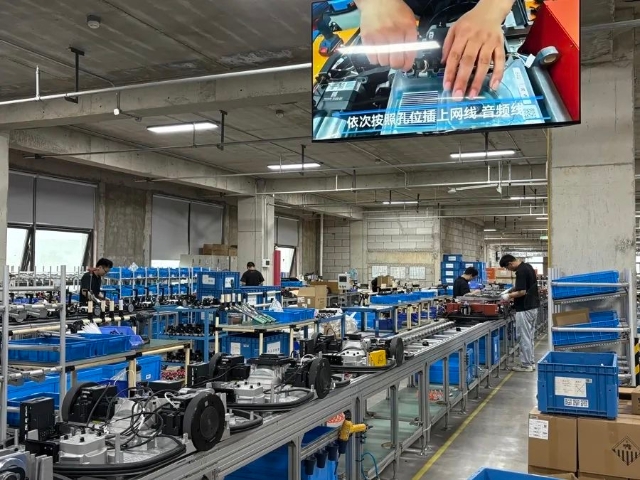Mobile Robot Company Sets Up Factory in Shanghai: Shanghai Holds an Unmatched Edge in Technological and Industrial Innovation
Last month, the Quicktron Global Intelligent Robot Industrialization Base, located in Gucun, Baoshan District, Shanghai, finally welcomed its R&D staff and production line workers.

“Now we have over 300 people at the headquarters, and parking is tight every day. See—Brother Wei got here late and had to squeeze in by the gate,” said Sun Di, Director of Domestic Market at Quicktron, pointing to a silver-gray car.
The “Brother Wei” he mentioned is none other than Yang Wei, founder and CEO of Quicktron. Three years ago, shortly after Shanghai released its policy to accelerate the transformation of its northern and southern regions (including Jinshan and Baoshan Districts), Yang and the reporter had a conversation—albeit via phone due to his business trips—about the development of robotics and intelligent manufacturing enterprises in Baoshan.
Three years on, Yang is still traveling frequently, but now mostly overseas. As the global smart warehousing market expands, Quicktron, which focuses on intelligent mobile robots, continues to grow both domestically and internationally. “Busy” has become the norm for all Quicktron employees.
After years of construction, the Quicktron Global Intelligent Robot Industrialization Base in Gucun finally welcomed the move-in of R&D personnel and production workers last month.

Shanghai Industrial Park of Robotics (Photo by Jiang Diwen)
Tech professionals work in “container offices”.
Upon entering the base, one is immediately struck by the tech-centric atmosphere: the wall showcasing the company’s development journey is still under construction, and young engineers, some standing, some crouching, are debugging parameters on their laptops beside mobile robots undergoing testing. While the honor wall can wait, project delivery cannot.
According to Sun Di, the company has simulated a variety of customer scenarios in the base’s 7-meter-high open space. Engineers even moved their desks directly into the testing area to speed up debugging and refinement.
Since the open space cannot be equipped with central air conditioning and Shanghai’s rainy season is hot and humid, temporary shipping containers with air conditioning were installed as office cubicles. Thus emerged the sight of engineers working inside “containers”.
Beyond the seemingly austere facility conditions lies Quicktron’s defining strength: its technology-first ethos driving stable global expansion. From Dallas to São Paulo, Seoul to Singapore, the company has now served over 1,000 clients in more than 50 industries across over 20 countries, with overseas markets contributing 65% to 70% of its output value.
Because of the high volume of overseas orders, Quicktron simulates “goods-to-person” warehousing scenarios on-site. Reliable product delivery is critical for projects distributed across diverse regions in multiple countries. Instead of sending engineers abroad at high cost, it conducts R&D and system validation in China before shipping the solutions overseas.
In recent years, many Chinese mobile robot companies have expanded abroad, with Quicktron among the early pioneers. It entered the Southeast Asian market in 2017, identifying Southeast Asia and the Middle East as key drivers of its global strategy. In November of the same year, Quicktron robots were deployed in the first smart warehouse of the eWTP initiative in Kuala Lumpur, a joint project of Cainiao, Lazada (Southeast Asia’s leading e-commerce platform), and Pos Malaysia.
In the Middle East, Quicktron aligned with regional development goals and built a steady presence. At the IKTVA Forum and Exhibition 2025 in Saudi Arabia, Quicktron signed the MOU with energy giant Aramco to jointly establish an “Industrial Robotics Innovation Lab,” focusing on energy-specific technology adaptation and standards development—an initiative hailed by industry insiders as a powerful example of collaboration between Chinese smart manufacturing industry and Middle Eastern energy economies.

Quicktron (Baoshan) Global Intelligent Robot Industrialization Base featuring next-generation Goods-to-Person picking workstations with no more than 4-second shelf docking and flexible gravity casters. (Photo by Jiang Diwen)
The focus is on technological and industrial advancement.
Upstairs on the second floor is Quicktron’s submersible robot assembly line. Through an integrated system of robots, movable racks, hardware, and software, the company can help clients cut manual labor by 60% to 80% in warehousing operations such as replenishment, stocking, and picking.
Automation isn’t just about cutting costs. Sun Di explained that traditional cold-chain logistics relies on workers operating forklifts in -15°C warehouses—a job that’s increasingly hard to fill, and one that exacts a toll on human health. To solve this, Quicktron developed four-directional shuttle robots designed for high-density cold storage.
These robots can travel in four directions and move under shelves, enabling flexible dispatching on the same level. Combined with other devices like lifting machines and conveyors, and integrated with workstations, electronic tags, and scanners, they help free workers from harsh, cold environments.
The reporter couldn’t help but ask: Why bring a factory back to Shanghai, where labor and operating costs are much higher?
This was answered by Wang Zheyu, affectionately known at Quicktron as “Factory Director Wang” and a lean production expert. He explained, “You have to view it from the perspective of new supply chains and cost-effectiveness. If you’re doing OEM manufacturing, sure—other regions offer cheaper costs and lower living expenses. But we’re now delivering full products and system solutions, so the math is different.”
As a primary equipment manufacturer, Quicktron’s value lies in technology and supply chain innovation, which depend on talent. For R&D, they need experts in algorithms, software, mechanics, and autonomous driving. For assembly, they need skilled workers who understand various operating systems. “In terms of talent concentration, Shanghai simply cannot be matched,” said Wang.
He further noted that globally renowned robotics firms also adopt a strategy of developing in core cities. “If we aim to be a tech- and solution-driven advanced manufacturer, then relocating to Shanghai is a strategic decision for greater efficiency.”
As he spoke, a submersible robot rolled off the production line. A worker explained that the line includes nine stations, and a skilled operator can complete one robot in just 12 to 15 minutes. While some workers left after the relocation, new hires demonstrate rapid skill progression through the dual-track system: standardized corporate manuals paired with hands-on mentorship from veteran technicians..

Quicktron Production line on the second floor (Photo by Wu Yue)
More robot industry players are becoming our neighbors.
Three years ago, in an interview, Yang Wei mentioned that by establishing Quicktron’s presence in Baoshan District and becoming a neighbor to FANUC—one of the four key industrial robot manufacturers in the world—the company had not only found a peer, but also anchored itself to a higher development goal. Today, the area surrounding the Quicktron Global Intelligent Robot Industrialization Base is home to an increasing number of such peers.
According to a representative of the Shanghai Industrial Park of Robotics, the park has attracted more than 300 key enterprises, including 243 companies involved in robotics and intelligent manufacturing. Upstream companies like Shanghai Electric Power-Electronics Co., Ltd. and Shanghai Zhangchen Machinery Manufacturing Co., Ltd. focus on core component R&D and manufacturing. Midstream companies such as FANUC, Fronius, and Shanghai Gongchuan Technology Co., Ltd. are engaged in robot body development and large-scale production. Downstream, application development and system integration are represented by firms like SpeedBot Robotics Co., Ltd., WEISS China, and Shanghai Rouqing Intelligent Technology Co., Ltd.. The park has also expanded into niche areas including humanoid robots, smart medical devices, information technology, precision instruments, and low-altitude economy equipment. A synergistic ecosystem is taking shape, characterized by “industry leaders driving development and SMEs thriving alongside.”
In the first half of this year, the park has fully leveraged its complete robotics and smart manufacturing industry chain. It has actively conducted on-site visits and promotional activities in key industrial clusters across China, further advancing its efforts to attract high-quality investment. So far, 105 new companies have either registered or relocated to the park.
In this city, where talent and resources concentrate, something new is happening every week. Before the interview ended, Sun Di mentioned that Quicktron had just participated as a corporate representative in the China International Finance Expo 2025 the week prior.
Some may wonder why a smart manufacturing company would attend a finance industry event. But that would be a misunderstanding. While Quicktron may once have been just a service provider for banks’ fintech operations, today its cutting-edge technologies—such as intelligent mobile robots, big data, and AI—are already being applied in financial institutions.
For a fast-growing company like Quicktron, attending international trade shows remains important, but exhibitions held “right at the doorstep” are just as valuable. Staying in Shanghai means more opportunities—a promise the city continues to uphold for its enterprises.

宝山汇APP

上海宝山微信

上海宝山微博